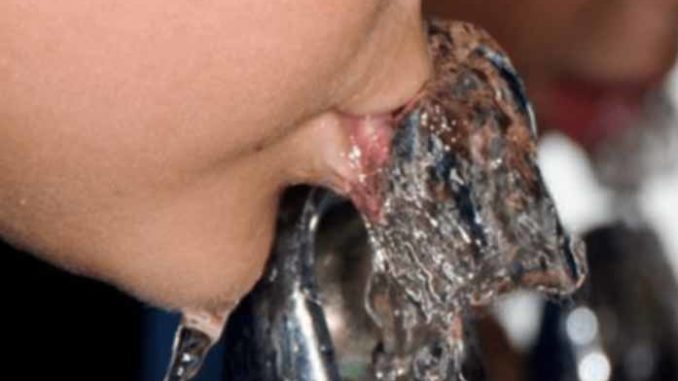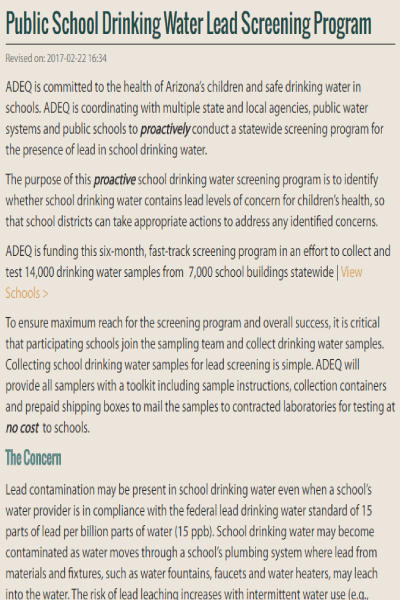
Officials were shocked this week when an email was sent out warning them not to tell parents of children at Hopi Elementary School that lead may exist in a water source. Specifically, Amanda Stone, Chief Policy and Legislative Affairs Officer for the Arizona Department Of Environmental Quality wrote, “ADEQ does not recommend notifying the parents at this time until receiving the confirmation results.”
Records show that the water was tested on March 24. Parents were eventually notified on May 8. Confirmation sampling has been ordered, but as of May 24, a date certain was not in ADEQ’s records.
The email reads:
Subject: Hopi Elementary School – ADEQ Public School Drinking Water Lead Screening Results
This email is sent on behalf of Amanda Stone, ADEQ Chief Policy and Legislative Affairs Officer.
As you may recall, you received a previous notification about the ADEQ Drinking Water Lead Screening Program and a school within your district that received sample results indicating exceedances of the EPA lead screening level.
I am writing today to alert you to results just received indicating an additional school within your district with exceedances of the EPA lead screening level of 15 parts per billion (ppb) in two drinking water samples. The school is Hopi Elementary School in Phoenix. The exceedances are as follows:
Result (ppb)
Fixture Type
Room, Building
31
Sink
Rm. J1, Bldg. J – Music
25
Sink
Rm. C7, Bldg. CADEQ is working with school representatives and the School Facilities Board to confirm the screening level exceedance. Since the exceedances were non-drinking water sources, the recommended immediate actions are to post a sign indicating that the source had tested positive for lead and not to drink the water.
Based upon recommendations from the Arizona County Public Health Directors and the Arizona Department of Health Services (ADHS), ADEQ does not recommend notifying the parents at this time until receiving the confirmation results. Therefore, I am providing you with the ADHS Health Communication Toolkit that we have also provided to the Superintendent Birdwell and the general timeline to conduct the confirmation sampling and receive the results.
In the event that you receive questions from press or constituents, please direct them to our website about the program: http://www.azdeq.gov/LeadScreeningProg.
Please don’t hesitate to contact me if you have any questions related to this initiative or specific questions about on-going sampling and mitigation activities at the Hopi Elementary School.
Respectfully,
Amanda Stone
Amanda E. Stone
Chief Policy and Legislative Affairs Officer
Arizona Department of Environmental Quality
As3@azdeq.gov
(Phoenix Office) 602-771-2248
(Tucson Office) 520-628-6883
(cell) 602-540-7657

Governor Ducey has attempted to tightly control other elected officials’ speech and actions. Lawmakers this year were advised by legislative leadership to not “do anything to embarrass the governor.” With the ability to kill good legislation with a veto, House and Senate leadership heeded the warning.
Earlier this year, Speaker of the House JD Mesnard, in the service of Ducey, blocked a hearing by Rep. Bob Thorpe in which the failures of the Ducey’s administration’s welfare benefits software program were to be discussed.
ADEQ’s lead testing program has been fairly opaque. Even a search for information about contamination is not easy. Once interested parties successfully search ADEQ’s website for the correct page, the link to the results is barely visible.
According to the Centers for Disease Control and Prevention (CDC) “there is no known safe level of lead in a child’s blood.”
From the EPA:
Young children, infants, and fetuses are particularly vulnerable to lead because the physical and behavioral effects of lead occur at lower exposure levels in children than in adults. A dose of lead that would have little effect on an adult can have a significant effect on a child. In children, low levels of exposure have been linked to damage to the central and peripheral nervous system, learning disabilities, shorter stature, impaired hearing, and impaired formation and function of blood cells.
The Centers for Disease Control and Prevention (CDC) recommends that public health actions be initiated when the level of lead in a child’s blood is 5 micrograms per deciliter (µg/dL) or more.
It is important to recognize all the ways a child can be exposed to lead. Children are exposed to lead in paint, dust, soil, air, and food, as well as drinking water. If the level of lead in a child’s blood is at or above the CDC action level of 5 micrograms per deciliter, it may be due to lead exposures from a combination of sources. EPA estimates that drinking water can make up 20 percent or more of a person’s total exposure to lead. Infants who consume mostly mixed formula can receive 40 percent to 60 percent of their exposure to lead from drinking water.
ADEQ “focused the screening program on school buildings constructed prior to 1987. The screening program also includes schools located in areas ADHS has identified as at high risk for childhood lead poisoning, as well as schools with schools educating children five years of age and younger. Because lead in drinking water may not be a problem limited to older buildings, the screening program also will include a limited number of newer school buildings constructed per the current lead plumbing requirements to verify the standards are in fact protective and not impacting drinking water.”
View Arizona School Lead In Water Testing Information|Results Here
